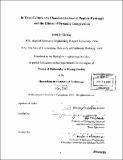| dc.contributor.advisor | Alan J. Grodzinsky. | en_US |
| dc.contributor.author | Kisiday, John D. (John David), 1970- | en_US |
| dc.contributor.other | Massachusetts Institute of Technology. Biological Engineering Division. | en_US |
| dc.date.accessioned | 2006-03-24T16:07:55Z | |
| dc.date.available | 2006-03-24T16:07:55Z | |
| dc.date.copyright | 2003 | en_US |
| dc.date.issued | 2003 | en_US |
| dc.identifier.uri | http://hdl.handle.net/1721.1/29614 | |
| dc.description | Thesis (Ph. D. in Bioengineering)--Massachusetts Institute of Technology, Biological Engineering Division, 2003. | en_US |
| dc.description | Includes bibliographical references. | en_US |
| dc.description.abstract | Emerging medical technologies for effective and lasting repair of articular cartilage include delivery of cells or cell-seeded scaffolds to a defect site to initiate de novo tissue regeneration. Biocompatible scaffolds assist in providing a template for cell distribution and extracellular matrix accumulation in a three-dimensional geometry. In these studies, a self-assembling peptide hydrogel is evaluated as a potential scaffold for cartilage repair using a model bovine cell source. A seeding technique is developed for 3-D encapsulation of chondrocytes in a peptide hydrogel. The chondrocyte-seeded peptide hydrogel was then evaluated cellular activities in vitro under standard culture conditions and also when subjected to dynamic compression. During 4 weeks of culture in vitro, chondrocytes seeded within the peptide hydrogel retained their morphology and developed a cartilage-like ECM rich in proteoglycans and type II collagen, indicative of a stable chondrocyte phenotype. Time dependent accumulation of this ECM was paralleled by increases in material stiffness, indicative of deposition of mechanically-functional neo-tissue. Culture of chondrocyte-seeded peptide hydrogels in ITS-supplemented medium was investigated as an alternative to high serum culture. Low serum (0.2%), ITS-supplemented medium was found to maintain high levels of cell division and extracellular matrix synthesis and accumulation, as seen in high serum culture. Furthermore, low serum, ITS medium induced minimal chondrocyte de-differentiation on the surface of the hydrogel. This is in contrast to high serum culture, where surface de-differentiation and subsequent proliferation led to a 5-10 cell thick layer that stained positive for type I collagen. | en_US |
| dc.description.abstract | (cont.) The effects of dynamic compression of chondrocyte-seeded peptide hydrogels were evaluated over long-term culture. A non-continuous loading protocol was identified in which proteoglycan, but not protein, synthesis increased over static, free-swelling culture. Increases in GAG matrix accumulation were observed after at least 8 days of loading, while hydroxyproline accumulation was unaffected by dynamic compression. These data demonstrated dynamic compression differentially regulated the synthesis of proteoglycans. Analysis of GAG loss to the medium indicated peak proteoglycan catabolism occurred immediately after the initiation of loading. This phenomenon was further explored using a modified loading protocol that increased GAG loss to the medium. Peak GAG loss to the medium was 2-fold higher than previously observed, resulting in GAG accumulation values significantly less than controls. Hydroxyproline accumulation was minimally affected by loading, demonstrating that dynamic compression also differentially regulated the catabolism of proteoglycans. Proteoglycan catabolism was not predominantly due to physical disruption accumulated extracellular matrix or loss of newly-synthesized molecules. Instead, the presence of MMPs in the medium that coincided with GAG loss suggest a potential enzymatic mechanism. These results demonstrate the potential of a self-assembling peptide hydrogel as a scaffold for the synthesis and accumulation of a true cartilage-like extracellular matrix ... | en_US |
| dc.description.statementofresponsibility | John D. Kisiday. | en_US |
| dc.format.extent | 140 p. | en_US |
| dc.format.extent | 6669848 bytes | |
| dc.format.extent | 11716447 bytes | |
| dc.format.mimetype | application/pdf | |
| dc.format.mimetype | application/pdf | |
| dc.language.iso | eng | en_US |
| dc.publisher | Massachusetts Institute of Technology | en_US |
| dc.rights | MIT theses are protected by copyright. They may be viewed, downloaded, or printed from this source but further reproduction or distribution in any format is prohibited without written permission. | en_US |
| dc.rights.uri | http://dspace.mit.edu/handle/1721.1/7582 | |
| dc.subject | Biological Engineering Division. | en_US |
| dc.title | In vitro culture of a chondrocyte-seeded peptide hydrogel and the effects of dynamic compression | en_US |
| dc.type | Thesis | en_US |
| dc.description.degree | Ph.D.in Bioengineering | en_US |
| dc.contributor.department | Massachusetts Institute of Technology. Department of Biological Engineering | |
| dc.identifier.oclc | 53120100 | en_US |
